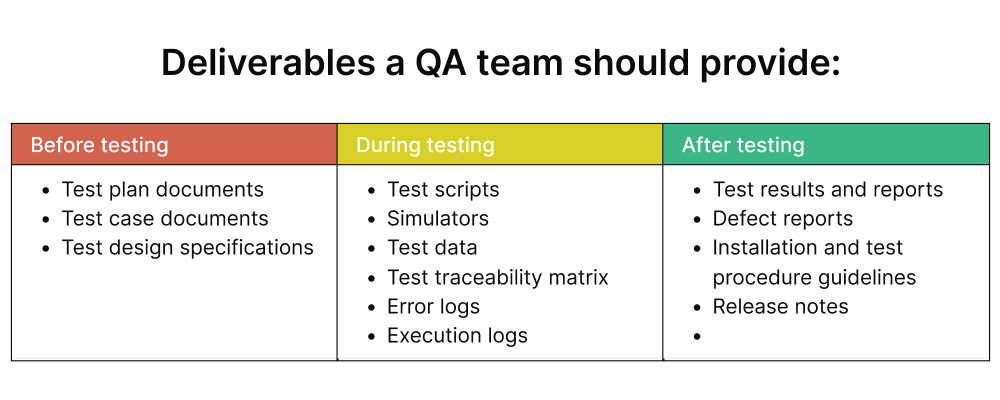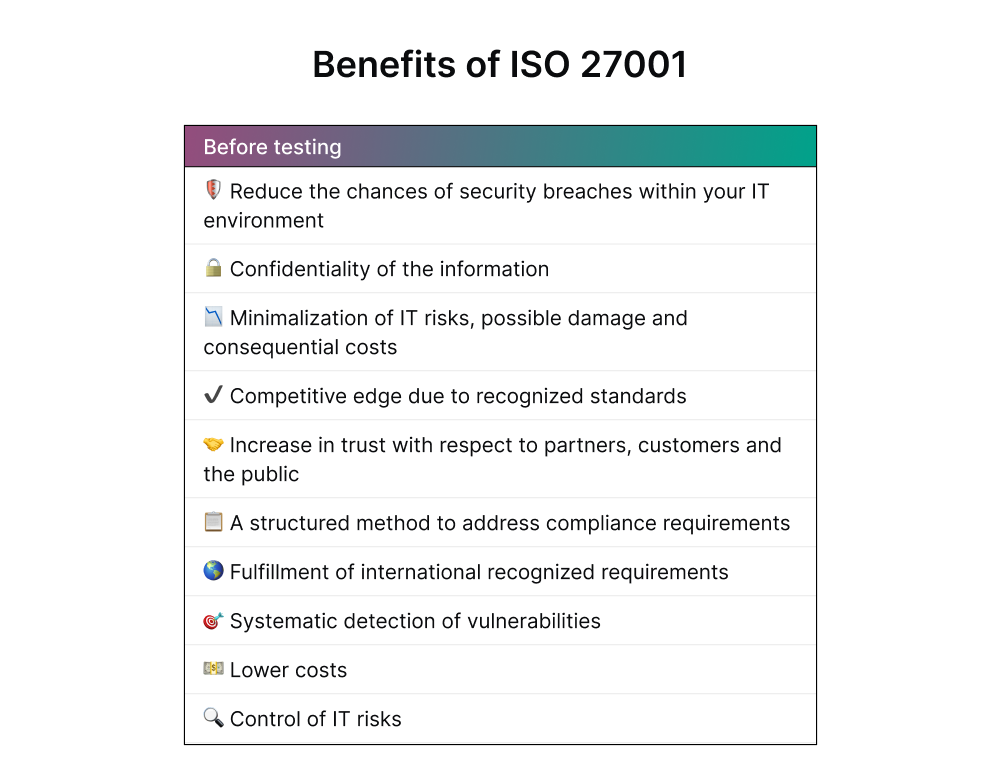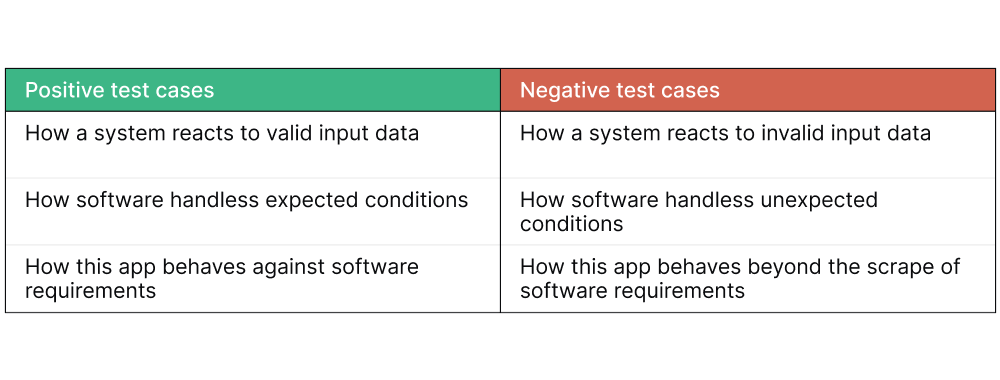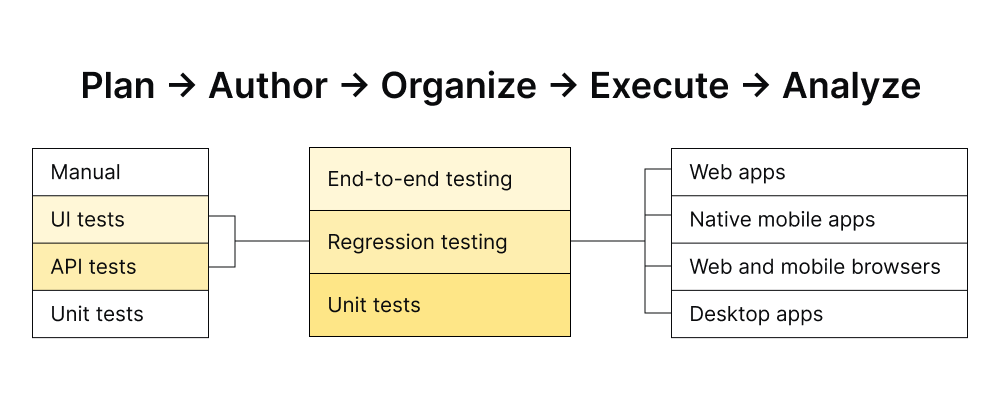14 Software Testing Best Practices to Build HQ Product
Fixing a bug discovered during implementation can be roughly 6x more expensive than addressing one identified during the design phase.
Additionally, rectifying an error detected after the product release is typically four to five times costlier than resolving issues found during the design phase and up to 100 times more expensive than those identified during the maintenance phase. However, software testing, while indispensable, is a time-consuming and costly process.
In this article, we will explore the software testing best practices, each a vital component in the quest for a robust, high-quality product. By adopting these practices, you can enhance the overall quality of your software, improve customer satisfaction, and ultimately optimize your financial performance.
Let’s jump in!
Arrange a discovery call today to learn how we can help your business make high-quality products
14 software testing best practices for effective software testing
1. Define clear testing objectives
The software testing process hinges on setting clear objectives for testing. These objectives should guide decisions throughout the testing phase. Fundamentally, testing aims to examine a software product's functionality and correct any issues before its release.
For maximum effectiveness, testing must be an integral part of the ongoing development cycle, having ongoing efforts instead of a pet project at the end. Interpreting the testing goals and setting precise project targets is essential. Otherwise, identifying why tests are conducted becomes hard.

You can define goals and objectives using the SMART criteria (Specific, Measurable, Achievable, Relevant, and Time-bound):
- Specific: Define goals precisely and clearly, leaving no room for ambiguity.
- Measurable: Specify the measurement tools and metrics to track progress and quantifiable outcomes.
- Achievable: Ensure that the goals are realistically attainable within the defined timeline.
Relevant: Align the goals with the overarching business or project strategy to ensure their relevance and significance. - Time-bound: Assign specific deadlines for accomplishing each goal to establish a sense of urgency and accountability.
2. Evaluate project risks
Analyzing potential threats must always come before you test any software project extensively. The significance of thoroughly assessing the possible hazards in advance is that testing is not always easy – it is challenging and can also burn a hole in your pocket. Hence, if you want to tackle these problems proficiently, make sure to incorporate essential risk appraisal techniques that can help you:
- Identify and mitigate project risks: Identifying and managing obstacles in technology, timetables, and resources is necessary for achieving desired outcomes.
- Project cost-benefit analysis: Decide whether the benefits of thorough testing outweigh the costs regarding product quality and customer satisfaction. Evaluate trade-offs and prioritize testing efforts accordingly.
- Manage risk: Develop a risk management framework that allows you to monitor and manage risks throughout the testing process.
- Ensure comprehensive test coverage: Thorough test coverage is crucial to rigorously check all aspects of the software, covering functionality, performance, security, and usability.
Create a well-rounded test suite, including unit, integration, system, and acceptance tests. Ensure coverage for both positive scenarios (expected functionality) and negative scenarios (error handling). In our experience, this comprehensive approach will significantly minimize the risk of unexpected defects and enhance the software's reliability.
3. Document test plans
Test planning and documentation are crucial aspects of software testing.
A comprehensive test plan is a roadmap for testing efforts, facilitating effective communication, risk assessment, and resource allocation.
It should define:
- The scope of testing,
- Objectives
- Test cases
- Testing methodologies
- Acceptance criteria.
In addition to outlining the testing process, the test plan should:
- Allocate resources,
- Define roles and responsibilities,
- Establish a timeline for testing activities.
4. Automate test cases
Automation is a powerful asset in software testing, streamlining the execution of repetitive and time-consuming test cases. This efficiency allows resources to be redirected towards thorough exploratory and manual testing, where human judgment is essential. Automated test scripts contribute to consistent and repeatable testing processes.
The use of automation has the potential to shorten testing duration while improving testing comprehensiveness, precision, and feedback speed. Automating repetitive tasks will help you complement your workforce, freeing you to concentrate on more complex and engaging responsibilities.
5. Do regression testing
Regression testing is a valuable technique that prevents unintended consequences resulting from code changes.
It verifies that new features and changes do not adversely affect existing functionality.
When performing regression testing:
- Select appropriate tests that cover critical functionality.
- Plan the testing process efficiently to ensure quick execution.
- Monitor and analyze results for any deviations or issues.
Automated test suites are particularly valuable for regression testing, as they can be quickly executed and repeated. You should use version control to track changes to test cases and consistently conduct regression testing throughout development.
This practice instills confidence in the team and stakeholders that the software remains stable and reliable. Why should you use regression tests, and when should you use them? There are three primary catalysts for initiating a regression test, each aiding in the facile identification of such a test.
1. Change in requirements & code
The first trigger occurs when there is a modification or enhancement in the application's code, often denoted as an "App change." This change can stem from alterations to the code, design, or existing features, generating bugs that serve as indicators for monitoring the app's stability and overall functionality.
2. New feature added
The second trigger involves adding new features, a commonplace occurrence, as these features undergo validation to ensure readiness for release. Executing this test necessitates an update to existing documentation and workflow.
3. Defect fixing is done for the raised bugs
The third and final trigger involves addressing and rectifying reported bugs from previous builds or rounds. These fixes are then assessed against the new build to determine their reproducibility. Notably, the resolution of 1-2 bugs does not automatically classify the test as a regression test.
Instead, the customary approach involves grouping fixes in larger batches, typically 50 or more, in the new version. The emphasis, however, lies not on the fixed bugs but on ensuring that the latest fixes have not introduced defects in other application areas.
6. Invest in a security testing environment
In an era of increasing cybersecurity threats and data breaches, security testing has become an imperative part of software development. Security testing includes penetration testing, vulnerability scanning, and code review to identify and rectify security vulnerabilities.
Robust security testing is essential to safeguard sensitive data and maintain customer trust. Identifying and addressing security vulnerabilities proactively during the testing phase is crucial, as addressing them post-release can be much more costly and damaging.
To establish a secure testing environment, you can follow these steps:
- Identify specific security needs.
- Evaluate available security solutions.
- Select and implement the appropriate security measures.
- Monitor the security environment regularly to address any evolving threats.
Pro tip
For example, some features can be sensitive, so you need to test your application in the most secure possible way, which Global App Testing can help you with. Whether you’re still trying to plan how you’re going to structure your testing framework, start executing the beta testing phase, or are looking to analyze the results of a testing phase, GAT has you covered.
Global App Testing comes with lots of features and capabilities that help make your software testing process more efficient.

What’s best is that Global App is the only crowd-testing platform with the enterprise-grade ISO 27001 security certificate.
Arrange a discovery call today to learn how we can help your business make high-quality products
7. Don’t forget about collaboration and communication
Effective collaboration and communication are cornerstones of successful software testing. Teams need to work closely, share information, and resolve issues collaboratively. Developers, testers, business analysts, and other stakeholders should collaborate throughout the project, aligning objectives and expectations. Regular meetings, such as daily stand-ups, are essential for keeping all team members on the same page.
Additionally, comprehensive documentation and transparent reporting are integral to efficient communication. Test reports provide a window into the testing process and its results, offering stakeholders insight into the testing progress and identified issues.
8. Employ training and skill development
Software testing is an ever-evolving field, and staying updated with the latest testing methodologies, tools, and industry trends is essential for delivering high-quality software. Encouraging team members to participate in training programs, workshops, and conferences can help keep their skills sharp and up-to-date.
Fostering a culture of continuous improvement and knowledge sharing within the team leads to more effective testing practices and better collaboration. A well-trained team is better equipped to deliver high-quality software that meets user expectations.
9. Implement continuous monitoring and feedback
Collecting and analyzing metrics are essential for assessing the quality of your software and the effectiveness of your testing efforts. Metrics such as defect density, code coverage, test case pass/fail rates, and performance benchmarks provide valuable insights into the state of the software.
These metrics help identify areas that need improvement, enabling data-driven decision-making. Continuous monitoring and feedback loops also allow for the swift identification and resolution of issues, leading to faster development cycles and higher-quality software.
10. Combine these concepts - shift-left continuous testing
Shift-Left Continuous Testing is an approach that emphasizes testing throughout the entire software development lifecycle rather than relegating it to a single phase at the end. It entails performing tests as needed, focusing on early and continuous verification of the software's quality.
The benefits of Shift-Left Continuous Testing include:
- Reduced development time and costs.
- Improved reliability and quality.
- Faster feedback and resolution of defects.
- Enhanced collaboration among team members, including developers and testers.
This approach will make it much easier for you to ensure a positive user experience and make your software work smoothly.
11. Ensure a suitable work environment for the QA team
A conducive work environment for the Quality Assurance (QA) team is essential for productivity and the overall quality of the testing process. It encompasses providing team members with comfortable, clean, well-maintained workspaces, access to necessary resources, and support to perform their tasks efficiently.
You should make sure to foster an atmosphere where team members feel valued and respected by you, which is vital for team morale and productivity.
12. Separate security and performance testing
Security and performance testing are distinct facets of software testing, each serving its purpose.
- Security testing focuses on identifying and mitigating security vulnerabilities.
- In contrast, performance testing assesses how well the software performs under various conditions.
It is crucial to conduct security testing in a secure and controlled environment, while performance testing should be carried out in controlled and real-world conditions. Separating these testing types allows you to isolate the effects of changes and gauge their impact on each aspect independently.
The test environment is typically configured to replicate the production environment. Here are various types of environments commonly used in the software development lifecycle that you can implement for better results and testing effectiveness:
1. Development environment:
- Primary use: Coding, debugging, and software testing by developers.
- Components: Development IDE, version control system, and a local development server.
2. Testing environment:
- Purpose: Testing software for bugs, errors, and other issues.
- Types: Unit testing, integration testing, performance testing, and user acceptance testing (UAT).
3. Staging environment:
- Utilization: Staging the software before deployment to the production environment.
- Characteristics: Typically, a scaled-down replica of the production environment.
4. Production environment:
- Main function: Live environment for deploying software for actual use by end-users.
- Significance: Most critical, as issues or errors here can have serious consequences.
5. Disaster recovery environment:
- Objective: Recovery from disasters or failures in the production environment.
- Components: Backup and recovery mechanisms, failover mechanisms, and other disaster recovery procedures.
6. Sandbox environment:
- Usage: Experimentation, training, and testing of new features or changes without affecting production.
- Additional role: Support teams may use it to troubleshoot and diagnose issues reported by end-users.
13. Embrace negative testing
Negative testing is a crucial practice that aims to identify potential issues before they escalate into serious problems. It strives to reveal potential bugs, errors, or security vulnerabilities that might go unnoticed during positive testing where valid inputs are used. The objective is to assess how a software system behaves when subjected to inputs that are either invalid or unexpected.
While negative testing can be challenging, it is instrumental in assuring software quality and adherence to user expectations. By embracing negative testing, it will be much easier to identify and rectify issues before they negatively impact the end users.

14. Have a mix of in-house and offshore teams
Many organizations adopt a hybrid approach, leveraging both in-house and offshore teams to optimize efficiency and flexibility. In-house teams can quickly respond to issues, while offshore teams offer autonomy and flexibility.
This combination allows organizations to assess their strengths and weaknesses and make necessary adjustments. Using a mix of in-house and offshore teams can lead to better quality control and resource management. However, it's essential to coordinate effectively and establish clear lines of communication to ensure seamless collaboration.
Pro tip
For example, Global App has a vast pool of over 50,000 available testers worldwide, allowing you to choose the ones that fit your business based on the geographical region, specific knowledge, or language preference. Also, you can either have a hands-on or hands-off approach with us.
Some of our clients prefer a fully managed approach, where we actively engage with them in developing and implementing the QA strategy. Our platform makes this process easy and convenient, giving you the flexibility to complete tasks without the need for interaction with our staff.
Conclusion
Creating high-quality software products requires a culture of excellence and establishing top-notch quality assurance teams to oversee the software testing and development processes. When incorporated effectively, these software testing best practices enhance product quality, user satisfaction, and successful project outcomes.
Arrange a discovery call today to learn more about our software testing and quality assurance, including the QA practices, tools, and how we can help your business make high-quality products.
We can help you to effectively test your software and keep it aligned to your business goals
FAQ
What is QA testing?
QA testing, or Quality Assurance testing, ensures that a software product meets specified requirements and functions correctly. It involves systematic testing, identifying and fixing defects, and ensuring overall product quality.
What is the difference between QA and testing?
QA (Quality Assurance) encompasses the entire process of quality management, ensuring that quality is built into every phase of the software development lifecycle. Testing is a part of QA and involves executing the software to identify defects.
What are the different types of testing?
There are various types of testing, including unit testing, integration testing, system testing, acceptance testing, regression testing, and performance testing, among others.
Why is testing necessary in software development?
Testing is crucial to identify and fix defects, ensure that the software meets user requirements, validate that new features work as intended, and prevent issues from reaching end-users.
Keep learning
70% of time saved for QA team at booking.com
Three ways that testing can drive global growth
How can testing support inclusive design?
We can help you to effectively test your software and keep it aligned to your business goals


